Found stones and lattice-form sculptures blur the lines between humanity and nature as well as between art and design in Sung Jang’s latest exhibition at Volume Gallery. Deriving from year-long research that brings natural materials into the gallery space, the Chicago-based designer and artist bridges the two disciplines by constructing forms that exist both as sculptures and as functional objects—all at once. “Given,” Jang’s new series of designed objects does exactly that. Read the full review here.
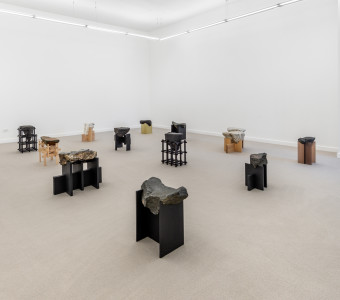
Newcity Design reviews Sung Jang: Given
December 16, 2021
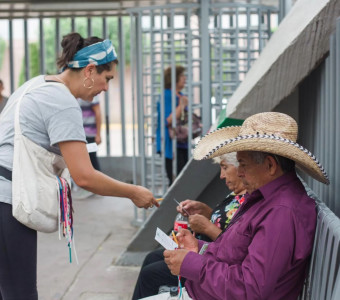
NPR: Tanya Aguiñiga wins award for highlighting life on the border
December 7, 2021
After immigration became a major issue in the 2016 campaign, artist Tanya Aguiñiga started walking among the cars and pedestrians lined up at the U.S.-Mexico border and handing out postcards with the question “What are your thoughts when you cross this border?” in both English and Spanish. Attached to the cards were two strands of fabric to be tied together. The result was Border Quipu – named after the Inca device for organizing information using knotted threads. The artwork, a cascade of thousands of recycled bikini and dress straps of different colors and prints, was one of the works cited by the judges of this year’s Heinz Award in selecting her for the $250,000 cash prize. More about Aguiñiga’s recent work and the Heinz Award here.
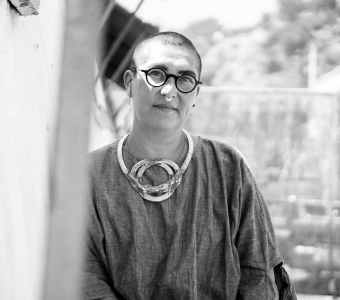
ARTnews: Artists Tanya Aguiñiga and Sanford Biggers Win $250,000 Heinz Awards
November 19, 2021
The Heinz Family Foundation has given out its two annual arts awards this year to Tanya Aguiñiga and Sanford Biggers. They will each receive an unrestricted cash prize.
Aguiñiga, who is based in Los Angeles, is best known for an interdisciplinary practice that blends craft, sculpture, and performance to think about issues related to migration—particularly as it relates to the U.S.-Mexico border at San Diego, where the artist was born—and Tijuana, where the artist grew up. Her 2020 piece Metabolizing the Border consisted of a bodysuit that incorporated pieces of the border wall that she then wore while walking along the wall into the Pacific Ocean. She is currently at work making car-crossing survival kits to help people endure the long waits in the heat that typically accompany attempts to legally cross the border. Read the full article here.
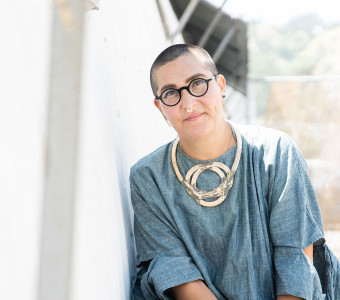
Tanya Aguiñiga named Heinz Award Recipient
November 18, 2021
The Heinz Family Foundation today named visual artist Tanya A. Aguiñiga as a recipient of the prestigious 26th Heinz Awards for the Arts, which annually recognize a small handful of outstanding individuals with a $250,000 unrestricted cash award.
Tanya Aguiñiga’s visual artworks blend contemporary craft, sculpture and performance to address issues of migration, gender and identity. Born in San Diego and raised in Tijuana, Mexico, she draws on her life experience as a binational citizen, who as a child crossed the border daily from Tijuana to San Diego to attend school. Ms. Aguiñiga’s work speaks of the artist’s experience of her divided identity and aspires to tell the larger and often invisible stories of the transnational community.
Often incorporating cotton, wool and other textiles, Ms. Aguiñiga blends traditional Indigenous weaving practices and materials and contemporary design into elaborate and colorful works that hang on walls, form immersive performance installations, incorporate film and more. In 2016, Ms. Aguiñiga created AMBOS (Art Made Between Opposite Sides), an ongoing series of projects that provides a platform for binational artists. Noted works include AMBOS: Border Quipu/Quipu Fronterizo, which captures reflections gathered from interviews with thousands of individuals crossing the border between the United States and Mexico. Travelers were also asked to tie a knot between pieces of fabric—the knotted fabrics reminiscent of quipu, an Incan method for recording information that included variously colored threads knotted in different ways—as a documentation of their crossing, together creating a large, colorful cascading installation. More about Aguiñiga and the Heinz Award here.
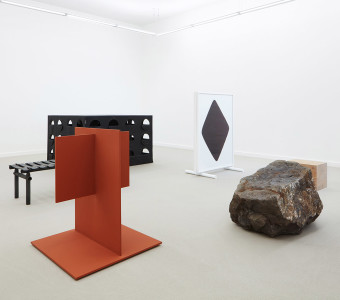
Sight Unseen reviews Jonathan Muecke
November 4, 2021
Jonathan Muecke’s New Works Are a Familiar Enigma
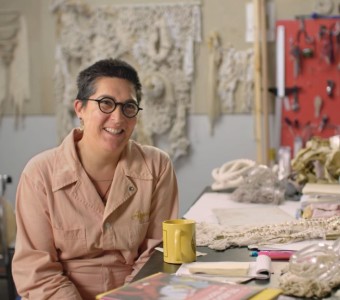
Artnet: ‘Not a Lot of Art Seems Accessible to Working-Class People’: Watch Artist Tanya Aguiñiga Explain How Craft Traditions Root Her Work in Community
October 29, 2021
As part of a collaboration with Art21, hear news-making artists describe their inspirations in their own words.
Tanya Aguiñiga was born and raised in Tijuana, and traveled everyday to San Diego to attend school. Growing up straddling the border and its disparate cultures, the artist was constantly in flux, a binational citizen who literally migrated between two worlds on a daily basis. Becoming an artist wasn’t something that felt attainable, she says in an exclusive video filmed as part of Art21’s Extended Play series. “There’s not a lot of art that seems accessible to working-class people,” Aguiñiga says. “Why does it have to be such a narrow view of what humanity actually is, and what humanity is actually experiencing?” Read the full article here.
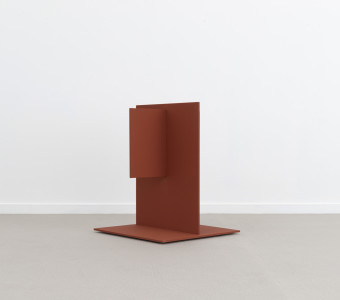
Newcity Design reviews Jonathan Muecke
October 22, 2021
Extraordinary Ordinary Objects: A Review of Jonathan Muecke at Volume Gallery
An enormous rock with holes, a solid wood block, a carbon tube bench, a textile box, a flat shape. Jonathan Muecke’s objects sound common or familiar, but don’t let that fool you—they are all quite extraordinary. Forcing the viewer to think outside of the box is Muecke’s biggest triumph. His elegant array of new objects, on view at Volume Gallery, makes for an interesting series where nothing is as it seems. Form, scale and material come together in unexpected combinations that remain open to interpretation. Furniture design meets sculpture, traditional meets hi-tech, and functionality meets the absurd. Read the full review here.
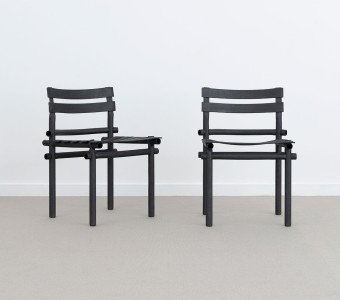
The Design Edit reviews Jonathan Muecke
October 15, 2021
An intellectual venture into function and form, yielding forms that are surprisingly tactile and visceral.
A GRADUATE OF the famed Cranbrook Academy of Art, Minnesota-based polymath Jonathan Muecke has dedicated his illustrious career to bending the boundaries of art, architecture and design. Like many of his contemporaries, Muecke’s cumulative oeuvre occupies an experimental and conceptual realm that questions the parameters of function and form. In his quest, the trained architect challenges cultural and social norms – while also skewing proportion and subverting historical symbols. His – what are ostensibly, sculptures – borrow references from furniture, material culture, everyday objects and architectonic elements. Ultimately, his refined forms exist to define negative and positive space and don’t claim any specific purposes. These liminal objects remain pure as instigations and studies. Represented by Chicago-based Volume Gallery and Brussels-based Maniera, he aligns with both platforms’ distinctive architectural programmes, that is architect-led furniture and object design. This focus often results in a more intellectual approach, one that employs the design medium to make larger statements about culture and society. It allows these practitioners the space and time to test out ideas they might not have within the constructed environment. Muecke takes full advantage of this approach and format. Read the full review here.
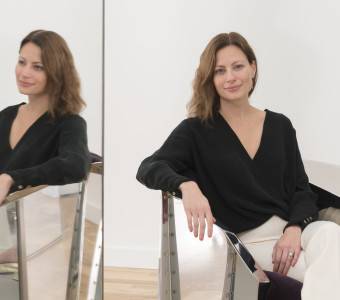
AN Interior In Convo: Claire Warner
October 14, 2021
Volume Gallery in Chicago wants nothing more than to cultivate new American design talent
It’s been more than a decade since Volume Gallery arrived on the collectible design scene, and in that time, the small Chicago-based platform has consistently punched above its weight. Chalk it up to pluck and sheer good taste: Volume has cultivated a roster of smart, experimental, critique-oriented talents that distinguishes it from the rest of the pack. Sam Stewart, Thaddeus Wolf, and Anders Herwald Ruhwald were all given a big push by the gallery. And it’s not just designers. Unique for collectible design, Volume invests in architects foraying into the realm of object making, working closely with practices including Norman Kelly and Young & Ayata. This mandate harks back to the discipline’s origins—in addition to buildings, architects once masterminded furniture and interiors—and aligns well with Chicago’s own design tradition. Volume’s reach isn’t limited to the Windy City, however, and the gallery routinely engages emerging practitioners from all over the United States. In many respects, it is more akin, according to cofounder Claire Warner, to an “incubator” for formal risk-taking, as can be seen in its most recent spate of exhibitions. Warner and cofounder Sam Vinz commissioned new collections from Christy Matson, Ania Jaworska, and most recently Jonathan Muecke, encouraging each to hone his or her ideas in order to spark critical discourse. AN Interior market editor Adrian Madlener spoke to Warner about the gallery’s mission and why making a functional chair is beside the point. Read the full interview here.
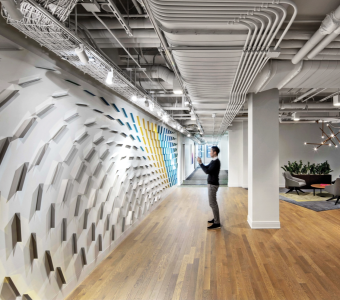
Interior Design on CannonDesign’s Cboe Global Markets in Chicago featuring a new installation by Luftwerk
September 29, 2021
Like their fellow practitioners around the world, floor traders at the Chicago Board Options Exchange have long communicated vital information via shouts and hand signals, the color and detailing on their jackets identifying their role, employer, and other crucial information. Behind the often raucous scene, however, predictive mathematical formulas—algorithms—play an increasingly important role in electronic trading. That paradigm shift prompted Cboe Global Markets, owners of the options exchange, the largest in the U.S., to replace its longtime home in Chicago’s financial district with a state-of-the-art headquarters. The company tapped CannonDesign to identify a suitable site for the new digs and design them. “Cboe sought a transformational environment,” begins design principal Mark Hirons, who led the commission with Meg Osman, Cannon project principal, “one that reflects its strength, global leadership, and pioneering innovation within the marketplace.” A hallway’s stainless steel wall installation by Luftwerk was inspired by wind patterns on nearby Lake Michigan. Read the full article here.
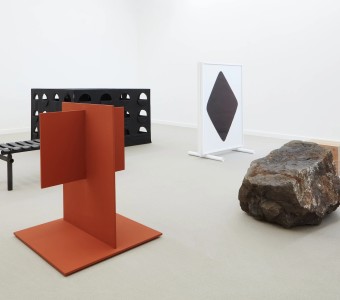
Design Miami’s The Buzz features Jonathan Muecke’s exhibition
September 28, 2021
Chicago’s Volume Gallery is currently hosting an exhibition of new work by Saint Paul-based designer Jonathan Muecke. Known for elegant forms that are hyper-specific in scale and material, Muecke has expanded his visual vocabulary with this show, creating shapes without clear precedent but instantly intriguing. The show is on view through October 30th. View Design Miami’s roundup of design world news here.
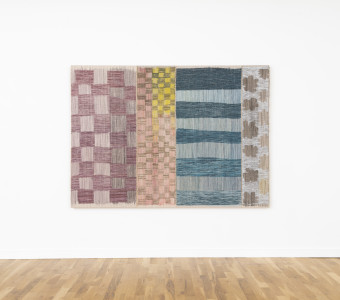
Christy Matson’s Magical Thinking recently acquired by the Milwaukee Art Museum
September 21, 2021
The Milwaukee Art Museum has recently acquired Magical Thinking, 2020 by Christy Matson. Christy Matson lives and works in Los Angeles, CA. Recent exhibitions include the Cranbrook Museum of Art, Long Beach Museum of Art, Craft and Folk Art Museum Los Angeles, Museum of Contemporary Arts Houston, The Milwaukee Art Museum, The Knoxville Museum of Art, the Asheville Museum of Art, and The San Francisco Museum of Craft+Design. Matson’s work is in the collection of the Los Angeles County Museum of Art (LACMA), the Art Institute of Chicago and Smithsonian Museum of American Art’s Renwick Gallery as well as numerous corporate and private collections. Matson received her MFA from California College of the Arts in 2005 and her BFA from the University of Washington in 2001. In 2012 Matson was tenured and appointed Associate Professor of Fiber and Material Studies at the School of the Art Institute of Chicago.
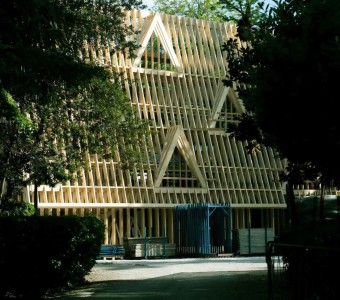
Ania Jaworska and Norman Kelley receive Graham Foundation Awards for 17th International Venice Architecture Biennale Project
August 26, 2021
Ania Jaworska and Norman Kelley awarded grants by the Graham Foundation for furniture explorations as part of American Framing: US Pavilion, 17th International Venice Architecture Biennale, by Paul Andersen, AIA, and Paul Preissner, AIA
Grantee: University of Illinois at Chicago—College of Architecture, Design, and the Arts, Chicago
Graham Foundation project description: Wood framing has always been wood framing, and no amount of money can buy you a better 2×4. This fundamental sameness paradoxically underlies the American culture of individuality, unifying all superficial differences. The exhibition presents the subject of wood framing in a collection of works throughout the galleries and grounds of the United States Pavilion at the 17th International Architecture Exhibition at the Venice Biennale. A four-story installation forms a new façade for the historic pavilion; photographic work from Daniel Shea and Chris Strong address the labor and design of softwood construction; scale models by students at the University of Illinois at Chicago School of Architecture study the history, common forms, and potential of wood framed construction; and furniture explorations by Ania Jaworska and Norman Kelley encourage connection to the work. More on the 2021 grantees here.
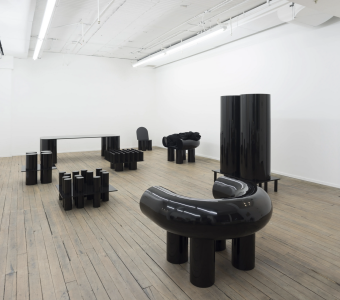
Meet the 2021 Chicago Architecture Biennial Contributors: Ania Jaworska
July 14, 2021
Newcity gets to know the 2021 Chicago Architecture Biennial contributors. This segment highlights Ania Jaworska, a Chicago-based architect, designer and educator whose practice explores the connection between art and architecture through bold simple forms, humor and commentary that references conceptual, historical and cultural narratives. She discusses her work reimagining the historic MLK District Garden in the North Lawndale community of Chicago, and the importance of addressing vacant lots and engaging with the communities at-large. Read the full interview here.
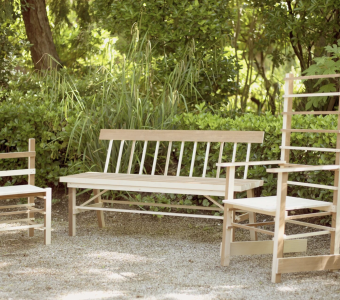
Celebrating the Very American Style of Building With Wood The United States Pavilion at the Venice Architecture Biennale pays tribute to wood framing — simple, cheap and revolutionary in its own way.
May 20, 2021
Furniture explorations by Ania Jaworska and Norman Kelley featured in “American Framing” at The United States Pavilion at the Venice Architecture Biennal covered by The New York Times.
“Since the Venice Architecture Biennale had its inaugural presentation in 1980, technology — particularly computer-assisted design — has transformed the field. Perhaps it’s not surprising, then, that the event’s latest edition, on view from May 22 to Nov. 21, looks forward to more cutting-edge developments in ‘Future Assembly,’ a special exhibition billed as a look at a world that ‘both includes and exceeds humanity.’ The United States Pavilion, however, takes the opposite approach, looking backward to the rise of a simple, cheap and very analog building tradition. ‘American Framing,’ the pavilion’s show, which was commissioned by the University of Illinois Chicago, focuses on the softwood construction that became typically American in the 19th century. The exhibition emphasizes the democratic, anonymous qualities of the process, whose impact is still felt today: In 2019, 90 percent of homes completed in the United States were wood-framed.
Mr. Preissner and Mr. Andersen also commissioned new furniture pieces constructed in a similar way. Four wooden benches in the show were designed by the Chicago architect Ania Jaworska in collaboration with the students. The firm Norman Kelley created three pieces of seating, all loosely inspired by classic forms like Shaker furniture and Windsor chairs, from common lumber. Two of each design — a rocker, a bench and a chair — will be in the show, and time-lapse videos will show how they were formed from basic wood planks. ‘We have a deep sympathy for history,’ said Carrie Norman, who founded the firm with Thomas Kelley. ‘We’ve always been drawn to a slower and more analog process.'” Read the full article here.
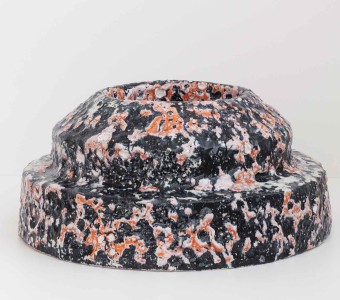
Five works by Anders Ruhwald acquired by the Art Institute of Chicago
April 30, 2021
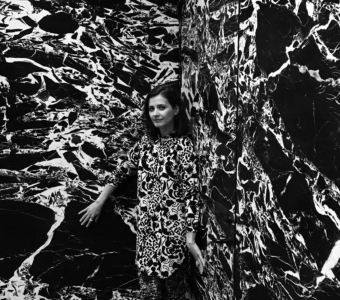
Chicago Architecture Biennial 2021 on community and urban space
April 29, 2021
Ania Jaworska has been announced as a contributor in the 2021 Chicago Architecture Biennial. The 2021 Chicago Architecture Biennial has announced its list of contributors – and it’s a rich, diverse and exciting one, tapping into critical ideas, such as urban and social sustainability, vacant spaces, diversity and community. The Chicago Architecture Biennial is gearing up for its fourth edition, and the organizers have just announced the contributors taking part this year, responding to the festival’s overall theme, ‘The Available City’. The list, rich and diverse, is exciting, tapping into innovators pomoting important ideas, such as urban space, social sustainability, diversity and community, instigating deep architectural debate. The festival’s artistic director David Brown has paired these creatives with local community groups in Chicago, and together the teams will explore ‘forms of shared, collective space and inspire new and imaginative uses of vacant spaces in the city’. As a result, events and exhibits will pop up across town, including neighbourhoods such as North Lawndale, Woodlawn, Bronzeville, Pilsen, South Loop, the Loop, and Edgewater. More on the Biennial here.
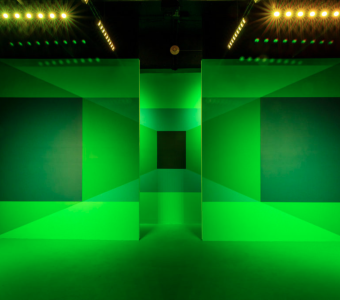
Luftwerk Open Square at The Mattress Factory
March 12, 2021
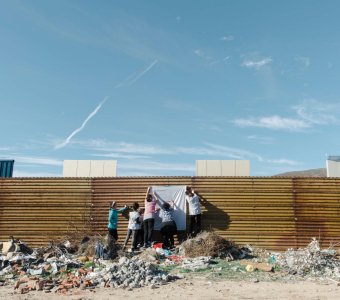
Tanya Aguiñiga in LatinXAmerican at the DePaul Art Museum
January 7, 2021